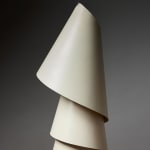

Man Ray
Man Ray’s Lampshade/Abat-jour realizes various ideas at the center of the artist’s work: the functional mobile, originally conceived of readymade material, comes to life as a practical yet playful lamp. The origin of this work came from manipulating found materials: in 1919, Man Ray took a strip of paper from a broken lampshade and attached the tip of the spiral to a dress stand. He was so taken with the result that he presented it to Marcel Duchamp and Katherine Dreier in the hopes of including it in the inaugural exhibition of the Société Anonyme in 1920, which the three had created as the first “experimental museum” of contemporary art; unfortunately, before it could be exhibited, the work was mistaken for garbage and disposed of. As a result, the artist recreated the work in tin and white paint. It was this secondary version that was photographed and reproduced in the artist’s lifetime. Although the original was lost, the central concept of the work remained with Man Ray throughout his career, popping up in paintings, as well as being re-editoned various times in the artist’s later life.
On the destruction of the original paper work, the artist stated, “Other contraptions of mine have been destroyed by visitors; not always through ignorance nor by accident, but willfully, as a protest. But I have managed to make them indestructible, that is, by making duplicates very easily.” [1] The spiral made an appearance in Man Ray’s photograph of Jean Cocteau and Marcel Duchamp as well as in his painting Retour à la raison from 1939, which is now in the collection of the Museum Ludwig in Cologne. Lampshade/Abat-jour was additionally revitalized by the artist when commissioned to take a series of photographs of Catherine Deneuve in 1968: he created a pair of spiral earrings for the model, directly based upon his earlier Dada creation. One of the editions that was kept in the artist's studio can be seen in various photographs of Deneuve in the background, echoing the shape of the earrings.
The present works comes from the 1964 re-edition with Editions MAT, executed in aluminum and sprayed with white paint. When suspended from the ceiling, the spiral spins, changing direction and speed, or coming to a pause in response to the movement of the air around it. In this work, both utilitarian and ready-made, Man Ray differs himself from his contemporary Marcel Duchamp, who pioneered the readymade object, whom almost always rendered his artworks non-functional.
[1] Man Ray, Self Portrait, Boston and Toronto, 1963, pp. 96–97

